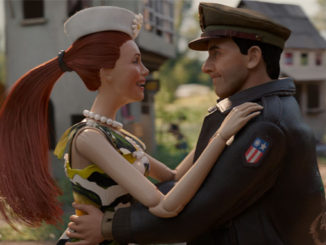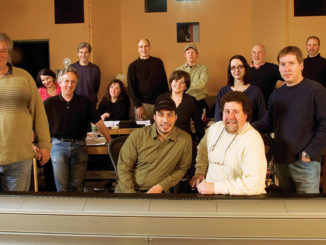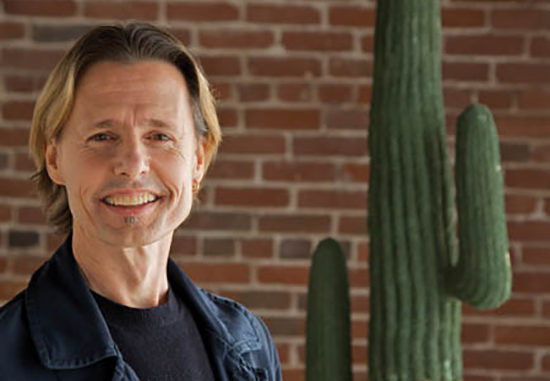
by Garrett Gilchrist
The first animated feature from special effects masters Industrial Light and Magic is Rango, a Western starring Johnny Depp as the voice of a chameleon with an identity crisis. The film opens nationwide March 4 through Paramount Pictures.
Taking his first feature film foray into animation, director Gore Verbinski, who worked with ILM helming the first three Pirates of the Caribbean films, directed the voice performances as if shooting a live-action film. Verbinski’s longtime collaborator, Australian editor Craig Wood––also a feature animation virgin––spoke with CineMontage to discuss how Verbinski’s live-action crew handled the challenges of animation. >>>
CineMontage: You’ve worked with Gore Verbinkski for a while now, even doing effects-filled commercials, such as the Budweiser Frogs.
Craig Wood: I met Gore in 1992. He’s tremendous fun to work with––irreverent in his humor and always giving his work a certain quirk and edge. He’s been incredibly loyal to me––for which I am immensely grateful…and a little protective. He’ll sit in the cutting room strumming his guitar, singing and making up ballads while we work.
We’ve now done eight features together. Over time, the communication becomes simpler and easier. Gore loves to talk in the abstract––and making the abstract a reality is our job.
CM: For Rango, there were 20 days of live-action filming; that’s very unusual for an animated film.
CW: Yes, with Gore’s same live-action crew––and very rudimentary props and costumes. The cast loved performing off one another, rather than reading into a microphone. The performances are much more natural and alive. Gore shot coverage––enough to get a feel of the performances, and some of the camera angles and shot sizes. There’s overlapping dialogue, a wonderful complicated back-and-forth. There was no motion capture. Rather, Johnny Depp called it “Emotion Capture.”
CM: It’s traditional in animated features to film live action as a reference, but not follow it exactly.
CW: A lot can be gleaned from the actors’ performances, but the character design is so radically not human that it certainly has to be interpreted by an animator. If you’re purely copying life, I’m not sure why you’re doing an animated film. ILM has a mastery of bringing life into these characters’ eyes. You’d swear they’re alive and real. I’ve seen shows where the eyes look completely dead, where the characters almost look blind.
There are no happy accidents in animation. You have to think of everything and create it. Everyone went to great lengths to create imperfection––lens flares and visual aberrations––and I tried to edit it as if it had been actually shot. I’d jump the action a little bit, or have action slightly overlap. We deliberately built in small continuity errors. I pride myself as a live action editor on bringing that to an animated film.
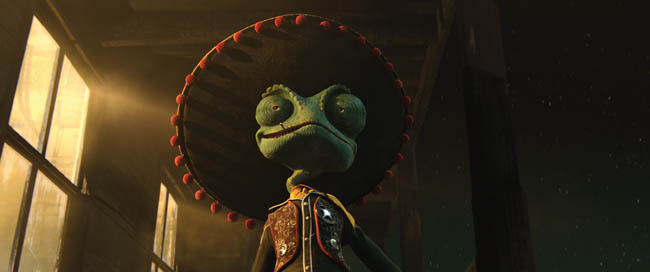
CM: On an animated film, editing begins with rough storyboards. How did it work on Rango?
CW: Gore worked on it over a year before I came on. He’d imagine a camera angle, and artists would draw and re-draw storyboards. Storyboard artist Jim Byrkit worked heavily on the story. He’s a good friend of Gore’s, and was the temporary voice of Rango that we all heard for a long time. I did a pass on the story reel, and we made some story adjustments. Once they recorded the actors, all the timings changed, and new ideas came out of that. ILM then did digital layouts, placing the characters in the scene in a primitive way, while Gore figured out the precise angles and blocking. It only goes to the animators once it’s locked for cut.
CM: What was your reaction as the finished shots were coming in?
CW: I’d never seen animation like this. These characters are alive; every little nuance. Our production designer, Crash McCreery, designed the world in all its minute detail and populated it with all these unique characters. ILM’s first animated feature had to be special. I think it took someone like Gore Verbinski to make this happen. Everyone was extremely excited.
I think we’re seeing a shift in what animation means. Pixar has pushed the envelope in films like Up. Avatar, while being motion capture, used animation techniques to realize its vision. They’re adult stories––which children are happy to watch––sophisticated emotionally, and aimed at all audiences. I love the original Disney films. Fantasia is extremely sophisticated. Animation is just another tool to tell a story, and we are telling stories in a more live-action way.
CM: The film is a sort of Spaghetti Western; even the title recalls Django from 1966.
CW: It’s a journey of self-discovery. Rango is forced to finally discover who he really is. We referenced Chinatown, and the Sergio Leone films Once Upon a Time in the West, and Duck, You Sucker––one of Gore’s favorites.
CM: Speaking of self-discovery, how did you get your start in editing?
CW: I was 19 and an assistant editor at the Australian Broadcasting Corporation. I gradually became a sound editor there on feature documentaries. To this day, I have a passion for sound. Sometimes I’ll create a complete soundscape for a scene before I cut a frame of picture––an emotional atmospheric bed, perhaps insects or spooky wind or tones. Some editors cut with music. I’d rather do it with sound.

CM: You did some uncredited sound design for The Ring?
CW: My good friend Peter Miller has been our sound designer on a number of the films we’ve done. He worked in Australia creating an enormous library of very unique sound work, which I’d cut into my sequences. We duplicated that for the final, because I’d been using the intended final sounds. Rango was quite similar; Peter created a large library of unique sounds for us.
On The Ring, the first thing I cut was the video that is the centerpiece of the film. Gore played the sound of that video to the actors to creep them out and set the tone. The video needed to be incredibly abstract, but also have a feeling of narrative structure. It wasn’t conventionally scripted. I took thermals––black-and-white images of what Gore had shot––and laid them on the floor. I wanted to see everything in front of me and move the pieces around as frames, not as moving images. “Well, we don’t need that one,” I’d think. We had only a couple of scenes that directly mimicked the Japanese version, but it was interesting to analyze. Why is that as scary as it is? There were certain scenes I thought worked particularly well. You don’t often get the chance to make that direct comparison. I tried to get the essence of the original without copying it.
CM: Talk about your first feature, Spirits of the Air, Gremlins of the Clouds.
CW: I started out editing music videos with Alex Proyas. Spirits was his first feature film, in Australia in 1986. It was certainly educational. Peter was the art director and sound designer, so we’ve known each other a long time. I’ve always been grateful for starting in music video. I still think of the entire soundtrack as music and the picture being another instrument playing along.
CM: You went to work for Gore on his first feature, Mousehunt.
CW: He wanted an ally, someone he knew and could trust and communicate with; I was delighted to be chosen. If I’d known what I knew at the end, I’d have been terrified, but I went in blindly confident and came out okay at the other end. The music videos and commercials we did were visual effects-driven, and I’ve had a passion for visual effects photography since my teens, so that didn’t scare me at all. Alex was very confident with effects, and Gore certainly is; he comes from an effects background. But the logistics of making a Hollywood feature film––navigating the minefield of politics––that’s always been a challenge.
CM: Tell me about cutting The Mexican.
CW: There are scenes between James Gandolfini and Julia Roberts that I think are magical. There are three flashback scenes that end with the clock tower chiming––just a soundtrack detail. At the end, Julia has to decide whether she’ll fire the gun. She fires, and a gold ring falls from the gun, in huge slow motion. I held the silence, and as it hits the ground, the town clock chimes again. It’s beautifully symmetrical. These things we bury in our work; I’m not sure anyone notices, but I think people feel that stuff.
Just as Gore has been loyal to me over the years, I’ve tried to be loyal to my assistants. Simon Morgan has assisted me on every one of the films I’ve done, and has been my first since The Mexican. It’s hard to imagine doing a film without him.
CM: Between the first two Pirates of the Caribbean films, you did The Weather Man.
CW: I’m particularly proud of that one. One of the reasons I love working with Gore is that everything we do––when it’s not a trilogy––is completely different. We’ve never done an animated film, and we’re figuring out our own way of doing it on Rango; finding ways to break the rules and make that work. Whatever you think of any of the films we’ve done, they’ve got integrity and uniqueness––and a voice that is very specifically Gore. I love supporting that voice.
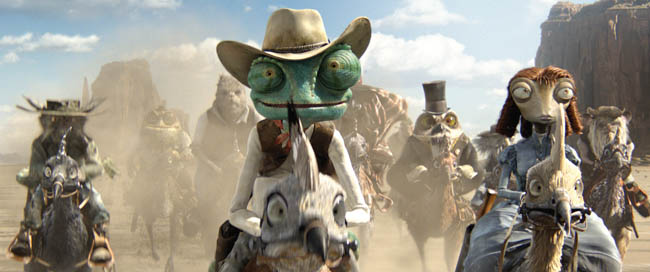
CM: But you’ve edited films other than Gore’s––Highway, James Cox’s first feature, for instance.
CW: There’s an excitement and energy in a first-time director that’s just infectious. It’s new to them and it becomes new to you. I love things to feel fresh; each film has to be testing me in some new way. Otherwise, an audience feels that staleness. Some studios would like things to be a little safer, but the most interesting films, and the biggest successes, are risks.
CM: Even Pirates of the Caribbean seemed like an unlikely hit on paper.
CW: I remember saying, “You’ve got to be kidding! An amusement park ride?” And we didn’t have a script yet. “What are you thinking?” But Gore pulled that one out! It was a huge rollercoaster ride, and so much fun.
CM: Johnny Depp’s performance as Jack Sparrow was a bold and unusual choice that made the film.
CW: I know, and I don’t think many people understood the performance until well after the film came out. Gore was very confident. Johnny knew what he was doing. But the producers weren’t sure. I wasn’t even 100 percent sure. I didn’t understand it, and toned it down quite a bit initially. We had to go back later and amp up those scenes to match the rest. It takes some figuring out, some teething time.
CM: You did Pirates 2 and 3 back-to-back.
CW: It was two very intensive years, right through. The schedule was tight; we had unmovable release dates well in advance––and far more visual effects. I’m especially proud of Pirates 2, the middle part of a trilogy. You have to be even more creative because you can’t rely on conventional story structure. How many editors have had the opportunity to cut a trilogy? They’re very complicated films. People love to revisit them; they keep finding something new. Rango is very much the same. In fact, to this day, I’m finding fantastic background details that have a joke, or are full of resonance to the scene, which I never noticed before.
“My philosophy has always been: The more finished it can seem as you’re cutting it, the better your choices are. Even down to spatial references, where you’ve placed things. It’s an upside-down process, editing before a frame of film has been shot.” – Craig Wood
CM: After Pirates, you did another director’s first feature, Guillermo Arriaga’s The Burning Plain.
CW: After Pirates, I consciously wanted to do something completely different––a serious drama. The producers, Walter Parkes and Laurie MacDonald, suggested me to Guillermo. “The editor of Pirates of the Caribbean? You have to be kidding me!” But he really liked me; he realized I’d cut The Weather Man, and that helped convince him. Pirates gave us all some respect, but there’s a curse with that too, because we don’t always want to be making one type of film.
CM: Well, doing an animated film is certainly something completely different. What was the process like on Rango?
CW: Rango is the first film I’ve edited in five-track stereo––full immersive surround. My philosophy has always been: The more finished it can seem as you’re cutting it, the better your choices are. Even down to spatial references, where you’ve placed things. It’s an upside-down process, editing before a frame of film has been shot. It gives you much more input. You not only can choose your takes, and the rhythm between shots, but you can adjust the rhythm internally in a shot before it’s animated.
CM: Now that you’ve almost finished one, what do you think of editing animated films?
CW: I’ve developed a huge respect for editors of animated films. Any live-action film I’ve ever worked on took less than a year. I’ve been on Rango for over two years now! It’s a huge commitment, but I’m proud and grateful to be involved. A lot of love went into making Rango. I know there’s a lot of me––and all of the key creative personnel––in it. And Gore, of course. So many performances owe a lot to his acting out facial expressions for the animators, encouraging them to “give it more fuzz,” a twist in a more interesting and unusual direction.
Things get tough, but even when we’ve had huge problems to solve, we just get to it and it’s fun. This past week, I’ve been in the best mood––and we’re working stupid hours. I think there’s something wrong with me!


